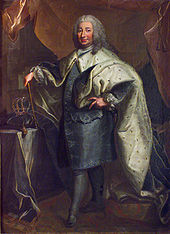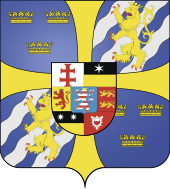Friedrich (Sweden)
Frederick of Hesse-Kassel (born April 17, jul. / 27. April 1676 greg. In Kassel , † March 25 . Jul / 5. April 1751 . Greg in Stockholm ) from the House of Hesse was from 1720 to 1751 King of Sweden and from 1730 as Friedrich I. also Landgrave of Hessen-Kassel .
Life
Hereditary Prince of Hessen-Kassel
Friedrich was the third son of Landgrave Karl von Hessen-Kassel (1654–1730) from his marriage to Marie Amalia , daughter of Duke Jakob Kettler of Courland . Friedrich's older brothers Wilhelm and Karl had died as small children and so Friedrich became Hereditary Prince of Hesse-Kassel in 1677.
After his training at the University of Utrecht , he went on cavalier tours from 1692 , first to the Netherlands , 1695 to Italy and later to study in Geneva . He then embarked on a military career, leading the Hessian troops in the War of the Spanish Succession as Lieutenant General alongside the Dutch and the imperial troops. He lost the Battle of Castiglione in 1706 .
On May 31, 1700, he married Luise (1680–1705) in Berlin , the only child of King Friedrich I of Prussia from his first marriage to Elisabeth Henriette of Hessen-Kassel . Luise died five years later without having given birth to children.
Marriage to Ulrike Eleonore
From 1710 Friedrich undertook marriage negotiations with the Swedish princess Ulrike Eleonore . After Ulrike Eleonore and her brother, King Karl XII. , agreed, the wedding took place on March 24, 1715 in Stockholm . After that, Friedrich took part in Charles XII's campaigns in 1716 and 1718. to Norway and was appointed Swedish Generalissimo . Charles XII. was unmarried and without male heirs, his succession not regulated. Advisors to the king favored Karl Friedrich von Holstein-Gottorf .
Among the historians who believe that Charles XII. was killed not by a stray bullet, but by murder, Friedrich is seen as the decisive force in this plot. The main proponents of this thesis at that time were the powerful supporters of the Duke of Holstein-Gottorf.
Ulrike Eleonore was only elected queen at the Reichstag with great concessions. She wanted to make Friedrich co-regent as soon as she ascended the throne, but she could not prevail in the Reichstag of 1719. For the time being, Friedrich had to be content with the title “ Royal Highness ”.
Friedrich soon gained great influence over the government with the consent of his wife. He now had supreme command of the Swedish armed forces and headed the defense against Russian attacks. On his advice some parts of Pomerania to Prussia ceded to at its help against the Russian tsar I. Peter secure. Ultimately, Ulrike Eleonore abdicated in favor of her husband, and Friedrich was crowned king in Stockholm on May 3, 1720 . To do this, he converted from the Reformed to the Lutheran faith.
King of Sweden
Friedrich enjoyed great popularity among the Swedish public after he came to power. This changed in 1721 when Sweden had to cede Livonia , Estonia and parts of Karelia to Russia in the Peace of Nystad . He lost the duchies of Bremen and Verden to the Electorate of Braunschweig-Lüneburg and Stettin, Usedom and Wollin to Prussia. Friedrich thus bore the consequences of his predecessor's failed great power policy.
His attempt to increase his own position of power contrary to the current constitution, and his poor knowledge of the language caused increased opposition among the nobles. His wife's right of inheritance remained controversial. Friedrich also lacked authority, talent and understanding of Swedish conditions. The parliamentary strengthened more and more, and Frederick's title was soon only label, after he was deposed by the Swedish nobility parties de facto.
In the Hamburg comparison , he finally renounced the provinces of Bremen and Verden , which had fallen to Sweden in the Peace of Westphalia , which had already been occupied by Denmark in 1712 and sold by this country to Hanover in 1715 .
After the death of Landgrave Karl in 1730, Friedrich also became Landgrave of Hessen-Kassel. But he had to undertake to always treat Swedish interests with priority. On this occasion he visited his hereditary lands for the first and only time as the Swedish king in 1731 and confirmed the governorship of his brother Wilhelm VIII , which had already been determined by Karl in 1729 .
Friedrich now filled his time more with hunting and dealing with favorites and mistresses . In 1741 he once again advocated a war against Russia , which ended in a military catastrophe. In the Peace of Åbo 1743 Sweden Southern Finland lost. Adolf Friedrich von Holstein-Gottorp was appointed heir to the throne. Friedrich had duels forbidden during his reign and introduced an official system that regulated the award of medals . Among other things, Achatz Ferdinand von der Asseburg was in his service .
After several strokes , Friedrich died on March 25, 1751 in Stockholm.
progeny

Both of Frederick's marriages remained childless. But he and Countess Hedwig Ulrike Taube von Odenkat († 1744) were the father of the following illegitimate children who were raised to counts or countesses of Hessenstein , but were excluded from inheritance in Sweden:
- Fredrika Vilhelmina, called Mamsell Ehrlich (born March 1, 1733, † summer 1734)
- Fredrik Vilhelm (born March 10, 1735 - † July 27, 1808), Prince of Hessenstein
- Karl Edvard (born November 26, 1737 - † April 17, 1769), Count of Hessenstein
- Hedvig Amalia (born December 9, 1743 - † May 6, 1752), Countess of Hessenstein
To provide for his sons, he bought several goods in Schleswig-Holstein from 1739 to 1741, which were later combined to form the so-called Herrschaft Hessenstein .
ancestors
| Wilhelm V Landgrave of Hesse-Kassel (1602–1637) | |||||||||||||
| William VI. Landgrave of Hessen-Kassel (1629–1663) | |||||||||||||
| Amalie Elisabeth von Hanau-Münzenberg (1602–1651) | |||||||||||||
| Karl Landgrave of Hessen-Kassel (1654–1730) | |||||||||||||
| Georg Wilhelm Elector of Brandenburg (1595–1640) | |||||||||||||
| Hedwig Sophie of Brandenburg (1623–1683) | |||||||||||||
| Elisabeth Charlotte of the Palatinate (1597–1660) | |||||||||||||
| Frederick I, King of Sweden | |||||||||||||
| Wilhelm Kettler Duke of Courland (1574–1640) | |||||||||||||
| Jakob Kettler Duke of Courland (1610–1682) | |||||||||||||
| Sophie of Prussia (1582–1610) | |||||||||||||
| Amalia of Courland (1653-1711) | |||||||||||||
| Georg Wilhelm Elector of Brandenburg (1595–1640) | |||||||||||||
| Luise Charlotte of Brandenburg (1617–1676) | |||||||||||||
| Elisabeth Charlotte of the Palatinate | |||||||||||||
Note: Due to family marriages, the Brandenburg Elector Georg Wilhelm and his wife Elisabeth Charlotte are Frederick's two-time great-grandparents.
literature
- Wolf von Both: Friedrich I .. In: New German Biography (NDB). Volume 5, Duncker & Humblot, Berlin 1961, ISBN 3-428-00186-9 , p. 507 f. ( Digitized version ).
- Reimer .: Friedrich I. (Landgrave of Hesse-Kassel) . In: Allgemeine Deutsche Biographie (ADB). Volume 7, Duncker & Humblot, Leipzig 1877, pp. 522-524.
- Helmut Burmeister (Ed.): Friedrich. King of Sweden, Landgrave of Hesse-Kassel. Studies on the life and work of a controversial prince (1676–1751). Hofgeismar 2003. (Publication by the Association for Hessian History and Regional Studies from 1834 eV, available from the Hofgeismar City Museum).
- Christian Röth: History of Hessen , p. 322 ff.
- Franz Carl Theodor Piderit: History of the capital and residence city of Kassel , p. 298 ff.
- Friedrich . In: Theodor Westrin (Ed.): Nordisk familjebok konversationslexikon och realencyklopedi . 2nd Edition. tape 8 : Feiss-Fruktmögel . Nordisk familjeboks förlag, Stockholm 1908, Sp. 1255-1258 (Swedish, runeberg.org ).
Web links
- Literature by and about Friedrich in the catalog of the German National Library
- Historians' day, Kiel University
- The Coup King: An Explanatory Approach to the History of the Swedish King and Hessian Landgrave Friedrich I. Exhibition archive, Museum Hofgeismar
- Sweden, Friedrich I. King of. Hessian biography. (As of February 16, 2020). In: Landesgeschichtliches Informationssystem Hessen (LAGIS).
| predecessor | Office | successor |
|---|---|---|
| Ulrika Eleonore |
King of Sweden 1720–1751 |
Adolf Friedrich |
| Karl |
Landgrave of Hessen-Kassel 1730–1751 |
William VIII |
| personal data | |
|---|---|
| SURNAME | Friedrich |
| ALTERNATIVE NAMES | Friedrich I of Hessen-Kassel |
| BRIEF DESCRIPTION | King of Sweden |
| DATE OF BIRTH | April 27, 1676 |
| PLACE OF BIRTH | kassel |
| DATE OF DEATH | April 5, 1751 |
| Place of death | Stockholm |



